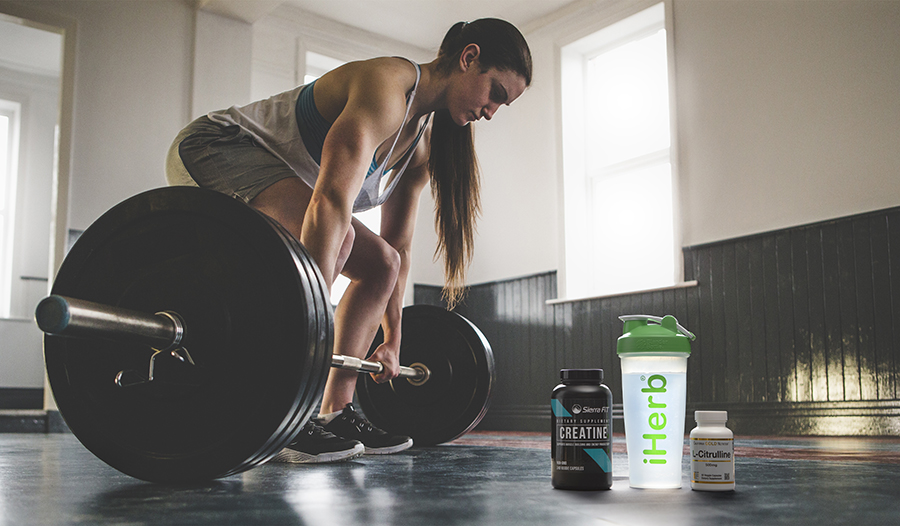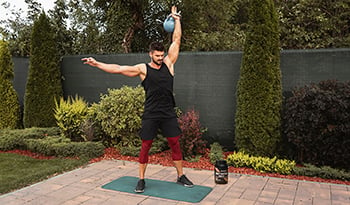3 Best Supplements to Consider for Muscular Hypertrophy
DISCLAIMER:This blog does not intend to provide diagnosis...
- In this article:
- What Is Muscular Hypertrophy?
- How Do You Train for Muscular Hypertrophy?
- 3 Tips to Improve Muscular Hypertrophy Training
- Hypertrophy Supplement 1: Creatine
- Hypertrophy Supplement 2: Protein Powder
- Hypertrophy Supplement 3: Citrulline

Lifters and athletes who hit the gym hard every week will generally have a few goals in mind for their training sessions. These goals usually revolve around strength, muscular hypertrophy, and other athletic and sport endeavors.
The goal of muscular hypertrophy is to bias one’s training to build larger muscles through the means of progressive overloading of muscle fibers by the means of resistance training. It’s important to understand that there are a ton of ways to approach muscular hypertrophy and everyone will respond slightly differently to various training styles based on individuality, training age, and much more.
In this article, we’re going to discuss muscular hypertrophy, how to apply this topic in the gym, and supplements that may support muscular gains. As always, before consuming any new supplement, it’s always a good idea to first consult a health professional to ensure you’re implementing the supplementation safely.
What Is Muscular Hypertrophy?
Muscular hypertrophy is the intent-focused enlargement of skeletal muscles. When focusing on muscle hypertrophy, there are a lot of things going on in the muscles to help create the physical change in size we see over time. Muscle hypertrophy doesn’t happen in a vacuum, and multiple components need to move together to increase a skeletal muscle’s physical size.
In the context of training, there are often two different types of muscle hypertrophy that are sought out:
- Sarcoplasmic hypertrophy, which means focusing on increasing a muscle’s capacity to store glycogen.
- Myofibrillar hypertrophy, which entails directly focusing on enlarging a muscle’s size by increasing muscle fiber size and density.
On top of there being multiple layers to muscular hypertrophy, it’s important to remember that it’s an adaptation that happens over time with consistency. While we may see sharper increases in strength in the gym when we first begin training, muscular hypertrophy can take quite a bit longer to physically manifest.
This can be due to individual differences in genetics, prior training history, and much more. That being said, when working to improve muscular hypertrophy, it is crucially important to be patient, consistent, and strategic with your means of chasing this adaptation.
How Do You Train for Muscular Hypertrophy?
While this article is about supplements that may support muscular hypertrophy adaptations, it’s also important to understand how to train for muscular hypertrophy in the first place. Why? Unfortunately, no amount of supplementation can make up for poor, non-strategic training.
When working to increase muscular hypertrophy, there is one major factor that most coaches agree on that can move the needle forward with improving one’s muscle mass. This factor is mechanical tension or the amount of tension that we’re placing on a muscle to create effort-driven levels of fatigue that will cause reciprocal levels of skeletal fiber growth.
Now the question is, how do we create mechanical tension and how can we strategize hypertrophy-focused training to improve muscular hypertrophy as a whole?
3 Tips to Improve Muscular Hypertrophy Training
For the sake of making this article applicable to every skill level, we’re going to discuss three key tips to help you program accordingly for muscular hypertrophy.
1. Tackle the Right Amount of Volume
The first characteristic to consider when trying to improve muscular hypertrophy is understanding how much exposure to certain stimuli each muscle physically needs on a weekly basis.
Everyone will be individual here, so it’s important to play around with your training intensity and volume as you grow as a lifter. To provide a starting suggestion, reference the below.
In a 2019 systematic review published in the International Journal of Environmental Research and Public Health, authors note that research is still fairly sparse for conclusive recommendations regarding intensity and volume, however, a good starting point for many is performing 3-6 sets of 6-12 repetitions with loading between 60-80% of one’s 1-rep max.
Then, as one adapts to this volume, increasing upwards to 12-28 sets per week per muscle group. Basically, as your training age and abilities increase, the volume and stimulus needed to move the needle forward will also need to increase.
When starting out, less can be more and you can always scale and increase. So, if you’re a beginner, try to avoid falling into the trap of “I need to bury myself in volume in order to grow”—that’s not necessarily the case, and there’s a lot more to the puzzle than that.
2. Train to Voluntary Failure, Sometimes
Once you’ve established a weekly volume that you’re tackling for each muscle group, now it’s time to establish how you’re pushing effort further, and this is where training to failure—sometimes—can be really useful.
We know that mechanical tension is a major driver of hypertrophy. To get the most bang for your buck, we need to then place a high level of mechanical tension on the muscle and take sets close to failure here and there to recruit as many muscle fibers as possible. Higher levels of muscular fatigue can be a great indicator for increased levels of muscle fiber recruitment.
Taking a few sets each week to failure at the end of your sets can be a really useful tool. Note: this doesn’t mean just take a max load and rep it out, but explore various tools for increasing the potential to create muscular hypertrophy.
Awesome tools can include things like rest-pause training, cluster sets, drop sets, supersets, and the list goes on. The main question to ask yourself is, “How can I take this muscle to mechanical failure without putting myself into a recovery hole and limiting my other training?”
3. Choose the Right Exercises
After you’ve established your weekly volume and the constraints in how you’ll push the effort to reach high levels of mechanical tension, it’s time to be strategic with your exercise selection. For a quick crash course, what I’d suggest is using exercises that allow you to efficiently isolate the muscle that you’re trying to create hypertrophy for and correspond with how the muscle’s fibers orient.
This could mean opting for a quad extension/hack squat to build the quads over a back squat, which has a higher skill level and greater potential of pushing one to fatigue in other areas before one’s quads reach technical failure.
On top of selecting exercises that can be a bit more isolated in nature, it’s also a good idea to look at muscle anatomy and pay attention to how the muscle fibers track. You don’t have to be an expert to do this either. We want to work with the fibers and how they physically orientate when creating contractions.
Hypertrophy Supplement 1: Creatine
Creatine is a cost-efficient staple for anyone trying to improve their muscular strength, size, and power output. Creatine monohydrate has a fair amount of research on it and it helps to improve overall strength and size by allowing lifters to train harder for longer periods while improving cell signaling, which can play a crucial role in muscular growth and repair.
To dial in your creatine supplementation, check out this comprehensive creatine guide.
Hypertrophy Supplement 2: Protein Powder
Protein powder itself isn’t necessarily going to manifest larger muscles in the body because again, we need to be training for muscular hypertrophy to do this. But, it can be a really useful supplement for long-term muscular repair and growth.
If we can consume adequate amounts of protein regularly with enough amino acids (the building blocks of protein), then we can hedge our bets for recovering and repairing our muscles after tough training sessions. Protein powder is easy to consume on a daily basis and goes well with things like shakes and oatmeal. Depending on your dietary needs and preferences, you can choose a whey protein powder, casein protein powder, or plant-based protein powder.
Hypertrophy Supplement 3: Citrulline
Citrulline is another supplement that warrants more exploration concerning its benefits for hypertrophy. When supplemented, citrulline can help improve the body’s nitric oxide production, which can help blood flow.
In the context of muscular hypertrophy, this could be useful for various hypertrophy training styles and transporting nutrients to the muscles more efficiently. Citrulline is an ingredient used in a variety of pre-workout formulas and pump products (if you’re looking for a non-stim option). Research suggests aiming for 3-6g of L-citrulline for maximizing potential benefits.

 By Jake Boly, CSCS
By Jake Boly, CSCS


